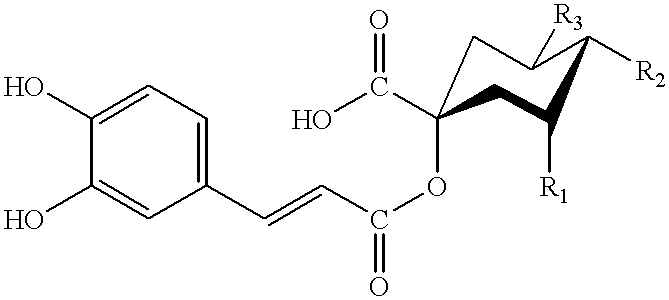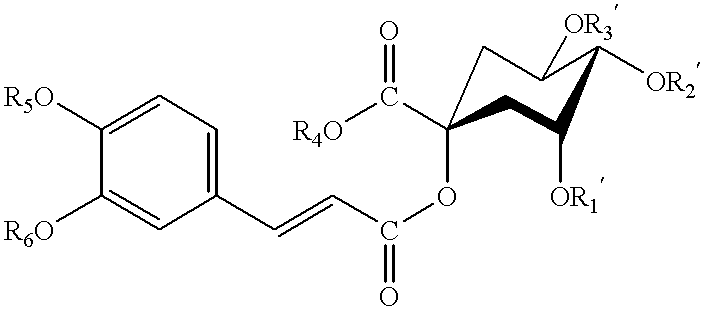Dicaffeoylquinic acid for treating hepatitis B and the diseases associated with retrovirus, and the new caffeoylquinic acid derivatives
a technology of dicaffeoylquinic acid and hepatitis b, which is applied in the field of dicaffeoylquinic acid for treating hepatitis b and the diseases associated with retrovirus, and the new caffeoylquinic acid derivatives, can solve the problems of high risk of cirrhosis and primary hepatocellular carcinoma, moderate to serious side effects of treatment, and transient effect, so as to reduce the appearance of syncytial
- Summary
- Abstract
- Description
- Claims
- Application Information
AI Technical Summary
Benefits of technology
Problems solved by technology
Method used
Image
Examples
example 2
Synthesis of Compound A
A mixture of 44.9 mg of carbonylcaffeic acid chloride and 25.4 mg of sodium acetone quinate is treated with 10 ml of DMF and 10 mg of DMAP at room temperature overnight, and then 40 ml of water and EtOAc were added while stirring. The EtOAc solution is evaporated, and the residue is hydrolyzed with 20 ml of 80% HOAc on boiling water bath for 30 min. After HOAc is removed, the residue (about 85 mg) is purified by silica gel chromatography, eluted with CHCl.sub.3 --MeOH--H.sub.2 O (90:35:6). The title compound (about 49 mg) is obtained. Its spectra data is the same as in example 1.
example 3
Synthesis of Compound A
53.5 mg of dichloromethylenecaffeic acid chloride is thoroughly mixed dry, powdered 25.4 mg of sodium acetone quinate in a flask immersed in an oil bath. The flask is put under vacuum and is heated first to 100.degree. C. and then, slowly, to 140.degree. C. maintaining this temperature for about 20-30 min. The molten mass is left to cool under vacuum, and then hydrolyzed with 20 ml of 80% HOAc on boiling water bath for 30 min. After HOAc is removed, and the residue (about 80 mg) is purified by silica gel chromatography, eluted with CHCl.sub.3 --MeOH--H.sub.2 O (90:35:6). The title compound (about 45 mg) is obtained. Its spectra data is the same as in example 1.
example 4
Synthesis of Compound A
A mixture of 53.5 mg of dichloromethylenecaffeic acid chloride and 25.4 mg of sodium acetone quinate is treated with 10 ml of DMF and 10 mg of DMAP at room temperature overnight, and then 40 ml of water and EtOAc were added while stirring. The EtOAc solution is evaporated, and the residue is hydrolyzed with 20 ml of 80% HOAc on boiling water bath for 30 min. After HOAc is removed, the residue (about 85 mg) is purified by silica gel chromatography, eluted with CHCl.sub.3 --MeOH--H.sub.2 O (90:35:6). The title compound (about 45 mg) is obtained. Its spectra data is the same as in example 1.
PUM
| Property | Measurement | Unit |
|---|---|---|
| Fraction | aaaaa | aaaaa |
| Fraction | aaaaa | aaaaa |
| Fraction | aaaaa | aaaaa |
Abstract
Description
Claims
Application Information
 Login to View More
Login to View More - R&D
- Intellectual Property
- Life Sciences
- Materials
- Tech Scout
- Unparalleled Data Quality
- Higher Quality Content
- 60% Fewer Hallucinations
Browse by: Latest US Patents, China's latest patents, Technical Efficacy Thesaurus, Application Domain, Technology Topic, Popular Technical Reports.
© 2025 PatSnap. All rights reserved.Legal|Privacy policy|Modern Slavery Act Transparency Statement|Sitemap|About US| Contact US: help@patsnap.com



